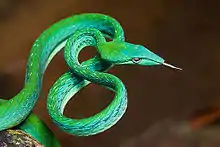| Ahaetulla prasina | |
|---|---|
 | |
| Scientific classification | |
| Domain: | Eukaryota |
| Kingdom: | Animalia |
| Phylum: | Chordata |
| Class: | Reptilia |
| Order: | Squamata |
| Suborder: | Serpentes |
| Family: | Colubridae |
| Genus: | Ahaetulla |
| Species: | A. prasina |
| Binomial name | |
| Ahaetulla prasina | |
| Synonyms | |
|
Dryophis prasinus Boie, 1827 | |
Ahaetulla prasina is an arboreal, moderately venomous species of opisthoglyphous snake in the family Colubridae to southern and Southeast Asia. Its common names include the Asian vine snake, Boie's whip snake, Gunther's whip snake, and the Oriental whip snake (Tagalog: puno ng ubas ahas; Thai: งูเขียวหัวจิ้งจก; Indonesian: ular anggur).[1]
Description

Legend
f – Frontal
in – Internasal
l – Loreal
la – Supralabial
la' – Infralabial
m – Mental
n – Nasal
p – Parietal
pf – Prefrontal
pg – Posterior Genials or Chin shields
pro – Preocular
pso – Presubocular
pto – Postocular
r – Rostral
so – Supraocular
t – Anterior and Posterior Temporals
v – First Ventral
The body form is extremely slender with a long, pointed, projecting snout which is rather more than twice as long as the eye. Adult colouration varies from light brown to dull yellow-green and often a startling fluorescent green.[3]
The type and number of scales is used to identify the snakes. In this species the internasals are usually in contact with the labial or lip scales. There are one to four small loreals between the prefrontal and the labial scales. The frontal is as long as its distance from the end of the snout or a little longer and a little longer than the parietal scales. There is one preocular scale in front of the eye, which is in contact with the frontal scale. There two postocular scales (behind the eyes). The temporal scales come in patterns of 2+2 or 3+3, rarely 1+2. Of the upper labial scales, the ninth, fourth, fifth, and sixth enter the eye while the 4 lower labials are in contact with the anterior chin-shields, which are shorter than the posterior chin-shields. The scales in 15 rows and are usually faintly keeled on the sacral region. There are 203-234 Ventral scales which are anal divided. There are 167 to 203 subcaudals which are bright green, pale olive, or grey-brown, with a yellow line along each side of the lower parts. The interstitial skin of the neck is black and white.[4]
Adults may attain 1.8 m (6 feet) in total length, with a tail 0.6 m (2 feet) long.[5]
Its appearance is very much like those of South American vine snakes. It is a rear-fanged species and is mildly venomous but is not considered a threat to humans.
Distribution
This snake has a wide distribution in Asia, where it occurs in Bangladesh, Bhutan, Brunei, Burma, Cambodia, China, India, Indonesia, Laos, Malaysia, Philippines, Singapore, Thailand, and Vietnam.[1]
Diet
The Asian vine snake feeds on small reptiles and amphibians, particularly lizards and tree frogs.
In captivity
In recent years, it has entered the pet trade and has become quite popular among hobbyists.
Subspecies
Four subspecies are recognized, including the nominate race.
- Ahaetulla prasina medioxima Lazell, 2002
- Ahaetulla prasina preocularis (Taylor, 1922): Philippine Islands, including Sulu Archipelago, Panay, Luzon.
- Ahaetulla prasina prasina (Boie, 1827)
- Ahaetulla prasina suluensis Gaulke, 1994: Philippine Islands, Sulu Archipelago
Gallery
References
- 1 2 3 Thy, N.; Nguyen, T.Q.; Golynsky, E.; Demegillo, A.; Diesmos, A.C.; Gonzalez, J.C. (2012). "Ahaetulla prasina". IUCN Red List of Threatened Species. 2012: e.T176329A1439072. doi:10.2305/IUCN.UK.2012-1.RLTS.T176329A1439072.en. Retrieved 19 November 2021.
- ↑ Dahms Tierleben. www.dahmstierleben.de
- ↑ "Oriental Whip Snake". Ecology Asia.
- ↑ Boulenger, G.A. 1890. Fauna of British India. Reptilia and Batrachia. British Museum. London. p. 369.
- ↑ Boulenger, G.A. 1896. Catalogue of the Snakes in the British Museum (Natural History), Volume III. London.
- Boulenger, G.A. 1897 List of the reptiles and batrachians collected by Mr. Alfred Everett in Lombok, Flores, Sumba and Saru, with descriptions of new species.Ann. Mag. Nat. Hist. (6) 19: 503–509
- Shaw, G. 1802 General Zoology, or Systematic Natural History. Vol.3, part 1 + 2. G. Kearsley, Thomas Davison, London: 313–615

.jpg.webp)
.jpg.webp)

